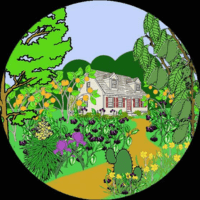Franklinia Tea Tree
Franklinia, Franklinia alatamaha is extinct in the wild since 1803! It was native to only the Altamaha River valley in Georgia, United States.
The Franklinia Tea Tree’s history is interwoven with American history. It’s discovery and cultivation was disrupted by the US Revolutionary War! Then there’s the father and son — both American botanists — who discovered and saved it! And even today, there’s an academic dispute over it’s genus (Franklinia, Gordonia vs Schima genera). What is certain is it’s beauty, as well as it’s rarity.
Why tea? Clinical research found that leaves of the Franklinia has compounds similar to green tea, Camellia sinensis. Catechins is the SUPER beneficial antioxidant agents in Green Tea. Green Tea is “widely known for its anticancer and anti-inflammatory properties.”
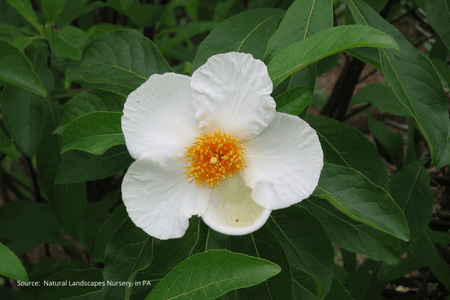
Franklinia Tea Tree Guide on ONE webpage!
Plant guide for Franklinia alatamaha
- SEVEN reasons why the Franklinia is the MOST unusual North American plant
- Fact Sheet
- Franklinia Attractive Attributes
- Franklinia Tea?
- Franklinia Tree Care and Propagation
- A seriously unusual history
- Franklinia Growing in our Garden
________________________________________
see our list of 400 edible plants
YouTube channel (please subscribe)

7 reasons why the Franklinia is the MOST unusual North American plant
7 reasons the Franklinia Tea Tree is SO unusual:
- Extinct in the wild!
- It’s pictured on TWO US stamps!
- Named in honor of Benjamin Franklin.
- It’s a tea tree and NATIVE to North America!
- Grown ONLY in botanical public and private gardens.
- The rarest plant to ever be conserved (in America, I assume).
- All trees known to exist today are descended from seeds collected by American botanists, John and William Bartram (late 1700’s).

Franklinia Fact Sheet
the Franklinia Tea Tree, Franklinia alatamaha is also known as Franklinia or Franklin Tree.
in Europe, it’s species name is often known as Gordonia pubescens. there’s an unsettled academic dispute over the genus and official name :/
Zone: 5 to 8
Height: up to 20 feet (6m)
Self-fertile: I cannot find information
Sun: Full sun to part shade
Water: medium (wilt and root rot can be serious problem)
Soil: well draining (wilt and root rot can be serious problem)
Suggested Use: Flowering Tree
Flower: Showy, Fragrant
Leaf: Good Fall
Blooms: white flowers develop in July to August
Deciduous or evergreen: deciduous
Family / Genus: Theaceae / Franklinia
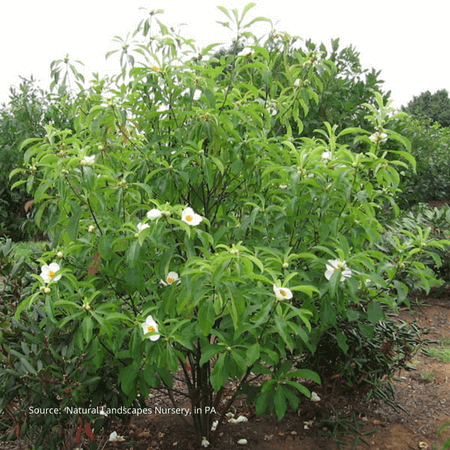
Franklinia Attractive Attributes
it’s a specimen plant because it’s rare and beautiful.
Franklinia Flowers
its flowers are special. it’s 3″ large and sweetly-fragrant flowers contrast beautifully with it’s lush green foliage. flowers are sweetly-fragrance and cup shaped.
the John Bartram Association writes,
“The flowers are numerous, and although each lasts only a day, at the peak of flowering the plant is covered day after day with blooms, often continuing for months until frost.”
Fall colors
Fall colors include shades of orange, maroon, burgundy, purple, lavender and red, including bright red.
Shape
they develop an rounded crown. single-trunk trees have a tendency to grow tallest (20 feet; 6 meters). multi-stemmed plants grow as a shrub. they are seen growing much shorter.
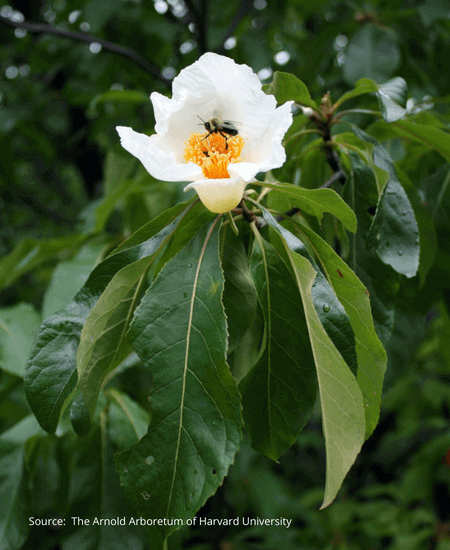
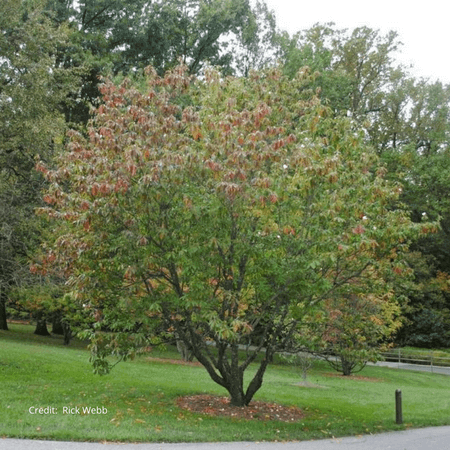
Franklinia Tea?
1 HEPPY cannot take any responsibility for any adverse effects from the use of plants. Always seek advice from a professional before using a plant for food or medicinally. This information is intended for educational purposes only and should not be considered as a recommendation or an endorsement of any particular medical or health treatment.
Edible Landscaping’s Michael McConkey mentioned that Franklinia alatamaha was used at tea in West Virginia. how Franklinia was abundant in WV is another topic :).
i researched the topic. Dr. Hassan Amjad of Beckley, West Virginia extensively researched Franklinia! Dr. Amjad was a medical doctor (geriatrician). he was described as a “genius, a healer, a tea enthusiast and an advocate.”
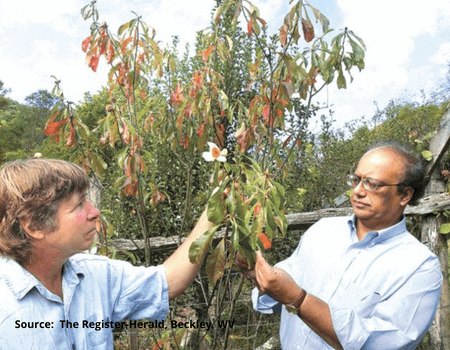
Clinical Research
Dr. Hassan Amjad’s conclusion is that “Franklinia alatamha has compounds similar to green tea, Camellia sinensis. Therefore, we expect to see the same medicinal benefits that green tea offers.” see The Society for Economic Botany (SEB) presentation on YouTube. Franklinia alatamha, An American Medicinal Tea Plant.
the relationship to Green Tea (Camellia sinesis) is important. Green Tea is “widely known for its anticancer and anti-inflammatory properties.” and, catechins are the “main antioxidant agents” in Green Tea, Camellia sinesis.
Green tea catechins are widely described to be efficient in the prevention of lung cancer, breast cancer, esophageal cancer, stomach cancer, liver cancer and prostate cancer (NIH / PubMed, Beneficial Properties of Green Tea Catechins).
catechins include epicatechin (EC), epicatechin gallate (ECG), epigallocatechin (EGC) and its stereoisomer gallocatechin (GC), epigallocatechin gallate (EGCG) and its stereoisomer gallocatechin gallate (GCG), with their compositions being similar for each other (NIH / PubMed, Catechins and Their Therapeutic Benefits to Inflammatory Bowel Disease).
Analysis of Franklinia leaves
Dr. Amjad found that Franklinia alatamaha leaves contained Catechins (0.35%), Epicatechins (0.51%), Epigallocatechins(0.33%), Epigallocatechin Gallate (0.1%), caffeine (0.18%), theophylline (0.02%), Theobromine (0.006%), Theoflavin (0.05%).
that’s how Dr. Amjad concluded that “F. alatamha has compounds similar to green tea, Camellia sinensis.”
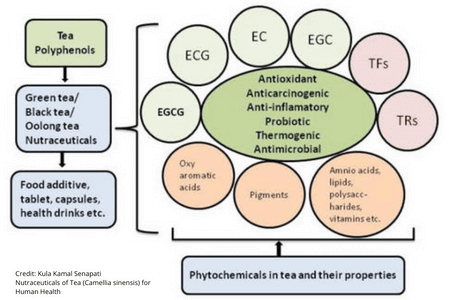
Theaceae, the Tea Family
Franklinia alatamaha is a species that belongs under the plant family, Theaceae. Theaceae is “the tea family.” so what does that mean?
the final 3 levels in scientific classification is Family / Genus / Species. in simply terms (that I need): Theaceae is the grandparents (Family). Franklinia the parent (Genus). Franklinia alatamaha is the child, so to speak (a specific plant — a species).
Theaceae includes species of flowering plants comprising shrubs and trees. species include tea plants that we consume (eg, Green Tea, Camellia sinensis) and ornamental camellias. most Theaceae are evergreen but the not the Franklinia 🙁
Stewartia and Gordonia genera in the Theaceae family. they include plants that look A LOT like the F. alatamaha. The Franklinia is still known as Gordonia pubescens in many European texts (Bartram’s Garden). scientists who performed DNA sequencing found that “The data also support the recognition of Franklinia as distinct although closely related to Gordonia” (NIH / PubMed, Phylogenetic relationships of Theaceae inferred from chloroplast DNA sequence data).
Franklinia Care and Propagation
Franklinia is a specimen tree or large shrub valued for its late summer flowers, good fall color and interesting history. it deserves a prominent location in the landscape (Missouri Botanical Garden).
General Care
DO NOT overwater F. alatamaha. however, she’s not drought tolerant and appreciates water so you must plant her in VERY well draining soil. wilt and root rot can be serious problems. our one small potted plant did well with no care … until I watered her heavily in preparation for planting. planting was delayed 10 days and by then, she was wilted. her outcome is pending :/
Franklinia Tea Tree is hard to transplant. so do your best to FIND a good location. it has a “sparsely fibrous root system, and is best left undisturbed once planted in the landscape” (Missouri Botanical Garden).
here’s something i’ve never seen: do not plant where cotton has been grown. there is a pathogen that affects cotton that also affects Franklin trees (NC State Extension).
Soil
Best grown in organically rich soil. add gravel, sand, perlite to the soil and plant on a mound, is my advice. we add 2-3 five-gallon buckets of gravel from our streambed for some plants. Rosemary, Texas Persimmon and Black Goji have gravel stones incorporated into the soil. we’ll do the same for the F. alatamaha we plant.
pH preference is acidic. the National Gardening Association recommends pH values 4.5 to 6.5.
NOT good is compacted clay soil and excessive moisture.
Sun
the online consensus is full sun in northern climates, but provide the F. alatamaha with afternoon shade in hot summer climates.
Patio Plant
Franklinia it makes a great plant for the patio! several credible references write that the Franklinia makes a good patio plant, despite her onerous reputation. “Its stature makes it a good choice for small spaces” (NC State Extension).
HEPPY™ recommends: use VERY loose soil to prevent excessive moisture. also, consider adequate shade because the Franklinia is not drought tolerant.
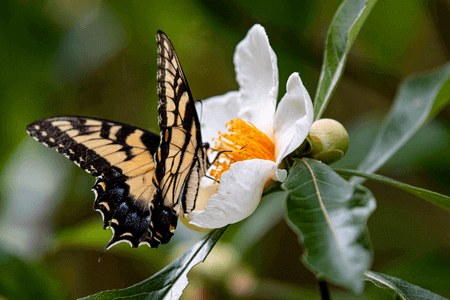
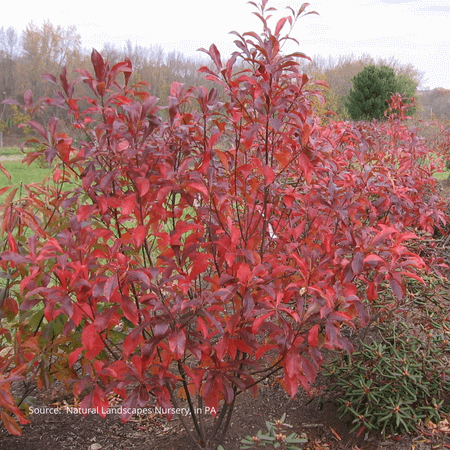
Rapid Healing
a very interesting observation was made by Dr. Hassan Amjad. he mentioned that Franklinia exhibited “rapid healing” when woody branches were injured (eg, the trunk, woody branches).
Propagation
very little information is online. many sources were reviewed for scant information. seed and cuttings are the only propagation methods found.
Seed
the seed of the Franklin tree develops over two growing seasons. following pollination in late summer, the fertilized egg (zygote) within the immature seed overwinters in a dormant state, before continuing its development in spring. by autumn, you can observe flowers and ripening fruit capsules on the tree at the same time. Credit: The Arnold Arboretum of Harvard University.
Dr. Hassan Amjad says that the seed pod stays on plant 12-15 months. He also said that seed germination rate is less than 10%.
do not let seeds dry. seeds do not store well. stratify seeds for 30 days if starting indoors. sow seeds as soon as possible (whether stratified, or if seeds are harvested directly from the plant and sown).
Cuttings
easily propagated from cuttings taken in late summer or fall, according to the Lady Bird Johnson Wildflower Center.
Franklinia is a deciduous woody plant. in general, collect cuttings in late winter when the plant is dormant. collect healthy wood of the previous season’s growth.
cuttings vary from 4 to 12 inches. the diameter of the cuttings should be between 1/4 to 1 inch. include at least 4-6 nodes. the bottom cut should be made just below a node and the top cut one-half to one inch above a node.
use a rooting hormone. tap the cuttings to remove excess hormone when using a powder formulation.
the rooting medium should be sterile and well-draining. use coarse sand, or a mixture of one part peat and one part perlite (by volume) one part peat and one part sand (by volume) is another recommended mix.
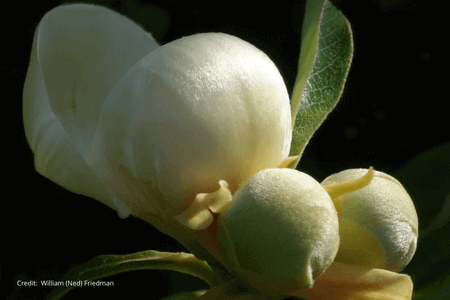
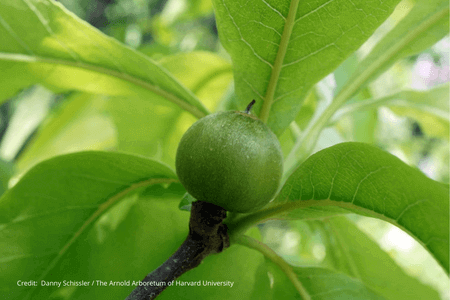

A seriously unusual history
a picture is worth a thousand words. but in this case, only a few words are needed. the red circle below was her native range in the late 1700’s. the Franklin Tea Tree has a seriously unusual history.
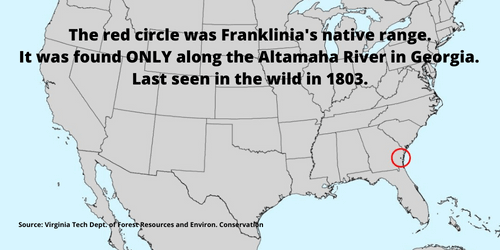
John and William Bartram discovered that “rare and elegant flowering shrub,” F. alatamaha, October 1, 1765. They had lost their way while crossing of the Altamaha River at Fort Barrington in southeast Georgia. William Bartram was the son of John Bartram. both were botanists from Philadelphia, Pennsylvania.
in subsequent years, William Bartram returned several times to the Altamaha River during collecting trip to the American South (1773 through 1776). he brought seed back to Philadelphia in 1777.
1803 as the last time F. alatamaha was seen in the wild, according to many online sources. therefore, William Bartram MAY HAVE harvested the last native F. alatamaha seeds.
call it dumb luck, very sharp botanical skills, or a little of both, all current trees are cultivated plants derived from the original seeds brought to Philadelphia by William Bartram.
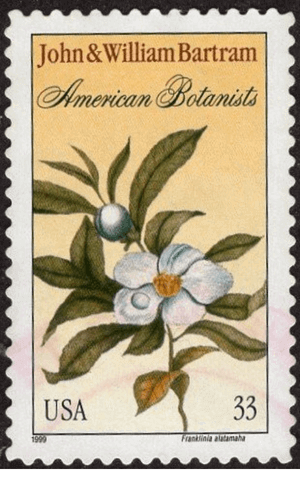
Why extinct in the wild?
overcollection by plant collectors, and fungal disease introduced with the cultivation of cotton plants.
New Genus and Species
William Bartram studied the plant for several years of study. there was nothing like it! so William classified it to a new genus Franklinia! how does someone know what plant is unique in the world? not sure. it is amazing that plants were so well know in those times.
the species name, alatamaha is named after the Altamaha River, where she was discovered.
Why the name?
John Bartram died in September 22, 1777. I believe that fully, or partly influenced William Bartram to name the Genus in honor of his father’s friend Benjamin Franklin. to this day, Franklin Tree is commonly used to describe F. alatamaha (in North America).
Becoming famous?
in 1785 the new plant name, Franklinia alatamaha, was first published by a Bartram’s cousin, Humphry Marshall. the name was published in Humphry’s catalogue of North American trees and shrubs entitled Arbustrum Americanum. (Marshall 1785: 48–50; Fry 2001).
North American plants could be sold in England. wealthy amateurs, and the titled nobility collected plants from around the world.
however, the John Bartram Association writes,
“Prior to 1900 the Franklinia was extremely rare in gardens, and could easily have been lost to the world altogether. Surprisingly, there is little record of significant effort to ensure its survival after 1850, when the last Bartram heirs were forced to sell the family botanic garden.”
Is she safe from extinction?
as of now, there’s no evidence that F. alatamaha was found in the wild. however, F. alatamaha is flourishing in cultivation. she’s rare but available for sale at several nurseries in America. i’ll provide the names of those nurseries to my YouTube subscribers 😉
Franklinia growing at HEPPY™
We're still trying ....
DON’T OVERWATER these girls like the dummy you see to the right!
yup, just days before planting I gave our potted girl and good soaking. after all, she’d been in the pot for almost a year until I created the ideal planting location!
she survived deer grazing, winter, and chilled at HEPPTY™ for a year but just before planting … I overwatered! the other issue was that I took about a week after watering her before planting. she declined quickly; she was toast by the time I went to plant her.
we’re a no BS operation and I describe the plant, my mistake and show the plant in this YouTube vid.
References
Bartram’s Garden, Franklinia Series: Finding F. alatamaha
Lady Bird Johnson Wildflower Center
Missouri Botanical Garden: F. alatamaha
National Gardening Association: Franklin Tree
Natural Landscapes Nursery, Franklin Tree
NC State University, NC State Extension
US Forest Service, How Are Rare Plants Conserved?
Virginia Tech Dept. of Forest Resources and Environmental Conservation
